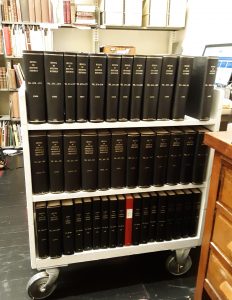This Spring semester has been challenging in many ways that we could not have anticipated when 2020 started. The changes have been immense. Nevertheless, as a community we grew stronger together, adapting, facing and overcoming new obstacles in order to provide our students with the best of us. As we reach the end of the term and reflect on what we have done, I invited our graduate research assistant at The Oliveira Lima Library, Erin Mir-Aliyev, to share her thoughts on her experience .
Erin is a graduate student in the Library and Information Science Department at The Catholic University of America and the first recipient of the Flora de Oliveira Lima Fellowship for Graduate Students in Library and Information Science. The fellowship honors Manoel de Oliveira Lima’s wife, a bibliophile in her own right who took charge of the library after his passing and left an unequivocal imprint on it.
Reflections on my first semester as OLL Copy-Cataloger
Erin Mir-Aliyev
Master of Science in Library and Information Science – The Catholic University of America
Flora de Oliveira Lima Fellowship for Graduate Students in Library and Information Science – The Oliveira Lima Library

Working as a graduate research assistant for the Oliveira Lima Library this spring has been a rewarding experience. Not only have I started to apply first hand in my work what I have been learning in my classes; I have gotten to work in a special collection focusing largely on resources containing information about history and culture, something that allows me to incorporate my social sciences interests and undergraduate degree in anthropology into my library career.
There were many different tools and software programs I’d heard about in my Fall classes, but not having worked in a library since high school, I was not in a position in which I got the chance to use them. As a visual and tactile learner, I was concerned that I was not truly grasping what was being taught. Since beginning to assist the Oliveira Lima Library with processing its collection late last Fall, I have noticed there are three areas in particular where I have learned a lot already and begun to grow more confident: accessing and using OCLC Connexion and Alma, and understanding MARC21.
OCLC Connexion
OCLC is a global library cooperative which provides a tool, OCLC Connexion, through which libraries can create and share their bibliographic records with other libraries. It allows copy-catalogers to find already-existing bibliographic records for their collection’s materials so that librarians don’t have to repeat work that has already been done. Before shadowing a cataloger, I had not realized how long creating one bibliographic record from scratch can take – often over an hour per record. OCLC Connexion has made it possible for me to discover and import into Alma bibliographic records for about 500 books since January, some of which are not very common. As a result, we have been much more efficient than we otherwise would have been at incorporating materials into the library. Going through this process has also allowed me to better understand which elements of a record are the most important for identifying it.
Alma
Alma is a cloud-based platform that allows libraries to manage their catalog by importing and editing bibliographic records found in OCLC. So far, I have completed this process for hundreds of books, as well as creating holding and item records for them. My understanding of the differences between a work, expression, manifestation, and item (as expressed by FRBR) has increased greatly as a result of going through this process. These differences are reflected in the differences between bibliographic, holding, and item records for a specific book.
MARC
MARC21 is a set of international standards for digital formatting of intellectual and physical traits of bibliographic materials, in my case, books. It struck me as very complicated and difficult to understand while in class, and I have been slowly memorizing the various field codes and formats for descriptions. Copy-cataloging for OLL is a more detail-oriented process than for a lot of collections due to the rare and unique nature of many of its materials, as individual books often contain inscriptions, signatures, or other markings and materials left by people significant to the history of the collection. The MARC fields most significant for cataloging of OLL resources are some fields also commonly used by general collections such as 100 (Main Entry – Personal Name), 245 (Title Statement), and 260 (Publication Information). However, culturally, historically, or biographically important information also needs to be included in the record; other fields like 561 (Ownership and Custodial History), 562 (Copy and Version Identification), and 590 (Local Note) focus on books’ rare and unique traits. This is where I am able to record details about who or what institution previously owned a book, or autographs and bound-in items like letters.


As I continue to work into the next semesters, I look forward to being able to learn even more, such as copy-cataloging for books written in other languages, how to classify and manage archival materials, and how to handle, categorize, and catalog artworks.
